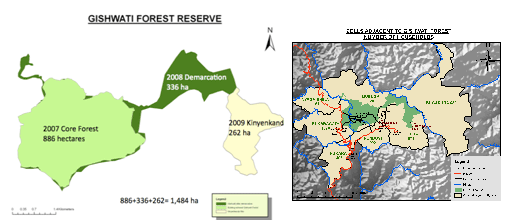Description of the Gishwati Natural Forest
The Gishwati Natural Forest is a secondary montane rainforest fragment located just south of Volcanoes National Park in western Rwanda (1° 49´ S, 29° 22´ E). It is part of the Congo-Nile Divide forest complex that includes Nyungwe National Park in Rwanda and the contiguous Kibira National Park in Burundi. Gishwati is isolated from these forests by 50 km. Currently Gishwati Natural Forest is the northern part of Gishwati-Mukura national Park.
The Gishwati Natural Forest is found in four Sectors of Rutsiro District, which are Kigeyo, Ruhango, Nyabirasi and Mushonyi. The total number of human population of these 4 Sectors is 85, 428 inhabitants with the density of around 430 people per km2 (National Institute of Statistics Rwanda, 2007). The community in Rutsiro District relies on subsistence farming, almost half of households farm on plots of half a hectare or less, and most plots are less than 1 hectare in size (National Institute of Statistics Rwanda, 2010).

Figure1: Map of the current Gishwati Natural Forest
Gishwati Natural Forest has a history of deforestation extending over the past 50 years, in part because of ill-advised large-scale cattle ranching schemes, resettlement of refugees after the genocide, inefficient small-plot farming, free-grazing of cattle, and establishment of plantations of non-native trees. As a result, the area is plagued with flooding, landslides, erosion, decreased soil fertility, decreased water quality, and heavy river siltation, all of which aggravate local poverty. In1970s, Gishwati forest was 28,000 hectares. In 2002, the remnant forest was only 600 hectares. The interest to restore Gishwati Natural Forest has been growing since 2002 when floods and landslides killed people in this area. The interventions include restoration activities of the Government Reforestation Project, Projet d’Appui a la Reforestation au Rwanda (PAFOR) from 2005 to 2008 and the ones of the Great Ape Trust/Gishwati Area Conservation Program (GACP) from 2008 to 2011.
This Forest is under different stages of regeneration. From 2005 to 2008, PAFOR increased the size of the Gishwati Natural Forest from 600 hectares to 886 hectares. From 2008 to 2009, GACP extended this forest up to 1,484 hectares. The 336 hectares added in 2008 have been reforested from late 2009 to early 2010 and the 262 hectares added in 2009 to stabilize steep hillsides in an area called Kinyenkanda that has been plagued by landslides and severe erosion into the Sebeya River, are under natural regeneration.
The Gishwati Natural Forest is a home of animal species that are under international alarm for protection. These are eastern chimpanzees (Pan troglodytes schweinfurthii, listed as Threatened on the IUCN Red List); golden monkeys (Cercopithecus mitis kandti, listed as Endangered); mountain monkeys (Cercopithecus l’hoesti, listed as Vulnerable); and more than 200 species of birds including 16 that are endemic to the Albertine Rift and two IUCN Vulnerable species: Martial Eagle (Polemaetus bellicosus) and Grey Crowned Crane (Balearica regulorum).
The ecosystem services that Gishwati Natural Forest generates are enormous. It has been estimated that the value of the carbon sequestered in the core forest of 886 hectares alone has the potential to contribute $3,000,000 per year to the Rwandan economy (Courard-Hauri &Boland (2011). In addition this forest serves local farmers, by absorbing and slowly releasing rainwater, preventing loss of topsoil, preventing sometimes-disastrous landslides, and stabilizing microclimate. The forest filters and purifies septic tank discharge and agricultural runoff. It produces organic material that enriches soil, and recycles vital soil nutrients – without the need for expensive chemical inputs. The forest is a continuing source of birds, bats, and insects that pollinate crops and aid in biocontrol of insect pests. Conversely, under a regime of deforestation, these benefits are not just lost locally but impacts are also felt miles downstream. Sebeya river on which Gisenyi town and its neighborlihood depends on for water and electricity and BRALIRWA brewery (the main beer brewery in the country) depends on for beer production has its water sources in Gishwati hills. For example, unchecked soil erosion turns the river and its tributaries coffee-brown, and the hydroelectric and water-dependent factories must close for months each year to clean the mud out of equipment. Such is the case for the Gihira Water Treatment Plant located in Rubavu District. Conservation of this Forest and restoring ecosystem services in the area will reduce these issues

